
Praktische Metallographie-Practical Metallography
Scope & Guideline
Exploring the Practical Frontiers of Metallography
Introduction
Aims and Scopes
- Microstructural Characterization:
The journal places a strong emphasis on the detailed characterization of microstructures in various materials, employing advanced techniques such as electron microscopy, X-ray diffraction, and nano-computed tomography to understand the structural properties and behaviors of metals. - Metallographic Techniques and Innovations:
It explores innovative metallographic techniques, including automated processes and advanced etching methods, aimed at improving sample preparation and analysis efficiency, ensuring reproducibility and accuracy in metallographic studies. - Applications in Industry and Archaeology:
The journal covers a wide range of applications, from industrial materials analysis to archaeological investigations, highlighting its interdisciplinary nature and the relevance of metallography in both modern engineering and historical studies. - Failure Analysis and Materials Performance:
A significant focus is on the analysis of material failures, where metallographic techniques are employed to diagnose issues in components used across various industries, aiding in the development of more robust materials and processes. - Sustainability and Environmental Impact:
The journal also addresses sustainability challenges within the metallurgical field, promoting research on recycling, green metallurgy, and environmentally friendly processes in materials production.
Trending and Emerging
- Advanced Automated Techniques:
There is a strong trend towards the integration of automation and robotics in metallographic processes, enhancing efficiency and precision in sample preparation and analysis, which is crucial for scaling up research to industrial applications. - Sustainable Metallurgy:
Research focusing on sustainability, including recycling processes and the development of environmentally friendly materials, is gaining prominence as industries seek to reduce their environmental footprint and comply with stricter regulations. - Characterization of New Materials:
The journal is increasingly featuring studies on the characterization of novel materials, including advanced alloys, composites, and materials derived from additive manufacturing, highlighting the need for effective analysis techniques in emerging technologies. - Interdisciplinary Applications:
There is a growing trend towards interdisciplinary studies that apply metallographic techniques to diverse fields such as archaeology, electronics, and energy, showcasing the versatility and relevance of metallography in various scientific domains. - Data-Driven Approaches and AI Utilization:
The integration of artificial intelligence and machine learning in metallographic analysis is emerging as a significant theme, enabling more sophisticated data analysis and predictive modeling of material behaviors.
Declining or Waning
- Traditional Metallographic Methods:
There is a noticeable decrease in the publication of studies focusing solely on traditional metallographic methods, as the field shifts towards more advanced and automated techniques that enhance efficiency and precision. - Historical Metallography without Novel Insights:
Papers that primarily focus on historical metallographic studies without integrating new methodologies or insights are becoming less common, reflecting a broader trend towards research that combines historical data with modern analytical techniques. - Basic Characterization Studies:
The journal appears to be moving away from publishing basic characterization studies that do not contribute significantly to the advancement of knowledge or application, favoring more complex investigations that provide deeper insights into material properties.
Similar Journals
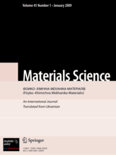
MATERIALS SCIENCE
Innovating Insights in Engineering and Physics.MATERIALS SCIENCE, a prominent journal published by SPRINGER, serves as a vital resource for researchers, professionals, and students in the fields of materials science, mechanical engineering, and condensed matter physics. With its ISSN 1068-820X and E-ISSN 1573-885X, this journal has been dedicated to sharing innovative research since its inception in 1993, and it continues to publish groundbreaking findings through 2024. Although it operates as a traditional subscription-based journal, its ranking in the Q3 quartile across multiple scientific categories, including Condensed Matter Physics, Materials Science, Mechanical Engineering, and Mechanics of Materials, signifies its relevance and impact in the academic community. Notably, its Scopus classifications reveal a competitive standing among its peers, ranking within the 25th to 33rd percentiles across various engineering and physics disciplines. The journal remains a key platform for disseminating valuable insights, fostering collaboration, and advancing the understanding of materials science.

PHYSICS OF METALS AND METALLOGRAPHY
Pioneering Research in Condensed Matter and MetallographyPhysics of Metals and Metallography, published by MAIK Nauka/Interperiodica/Springer, is a respected journal dedicated to the study of the physical properties of metals and their metallographic analysis, offering invaluable insights for researchers, professionals, and students in the fields of condensed matter physics and materials chemistry. With an ISSN of 0031-918X and an E-ISSN of 1555-6190, the journal has a rich history that spans from 1970 to 2024, reflecting a long-standing commitment to advancing knowledge in this vital area of materials science. Although it currently does not offer Open Access options, its strong placement in the academic landscape is underscored by its Q3 ranking in both Condensed Matter Physics and Materials Chemistry, according to 2023 metrics, and a Scopus ranking that places it within the competitive percentile of its fields. The journal is particularly important for those engaged in the cutting-edge research and technological applications of metals and alloys, making it an essential resource for anyone looking to deepen their understanding or contribute original findings to this dynamic discipline.
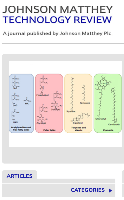
Johnson Matthey Technology Review
Driving progress in metals, alloys, and process chemistry.Johnson Matthey Technology Review is a premier open access journal published by Johnson Matthey Publishing Ltd, dedicated to advancing research and innovation in the fields of Electrochemistry, Metals and Alloys, and Process Chemistry and Technology. Since its transition to open access in 2014, the journal has provided a platform for scholars and industry professionals to share their findings and insights in a rapidly evolving field. Based in the United Kingdom, this journal has garnered significant attention, achieving impressive rankings such as Q3 in Electrochemistry and Q2 in Metals and Alloys, reflecting its growing impact within the scientific community. With a commitment to promoting high-quality, peer-reviewed research, the Johnson Matthey Technology Review plays a vital role in connecting researchers, facilitating knowledge exchange, and fostering collaboration across disciplines, making it an essential resource for anyone involved in material science and chemical engineering.

FATIGUE & FRACTURE OF ENGINEERING MATERIALS & STRUCTURES
Transforming Understanding of Material PerformanceFATIGUE & FRACTURE OF ENGINEERING MATERIALS & STRUCTURES, published by WILEY, is a leading journal in the domains of materials science and mechanical engineering, with a solid reputation for advancing research on the behavior of materials under fatigue and fracture conditions. With an impressive impact factor and ranking in the top quartiles of its categories in 2023, this journal serves as a vital resource for academics, professionals, and students interested in the intricate mechanics of materials. The journal encompasses a comprehensive scope, covering both experimental and theoretical methodologies designed to understand and predict material performance under various loading conditions. As the journal continues to thrive since its inception in 1979 and is set to converge until 2024, it remains an essential platform for disseminating innovative and crucial findings in this specialized field. Researchers are invited to explore the wealth of knowledge presented within its pages, paving the way for enhanced engineering practices and material design.
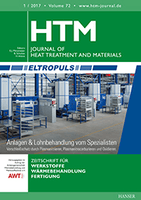
HTM-Journal of Heat Treatment and Materials
Advancing the frontiers of heat treatment and materials science.HTM-Journal of Heat Treatment and Materials, published by WALTER DE GRUYTER GMBH, serves as a vital platform for the dissemination of research in the fields of Industrial and Manufacturing Engineering, Materials Chemistry, and Metals and Alloys. With an ISSN of 1867-2493 and an E-ISSN of 2194-1831, this peer-reviewed journal focuses on the advancements and methodologies associated with heat treatment processes, materials innovation, and their applications across various industries. Notably recognized in the Q3 category for Industrial and Manufacturing Engineering and Materials Chemistry, as well as Q2 for Metals and Alloys, the journal has garnered significant attention, illustrated by its Scopus rankings, placing it among the scholarly discussions within the field. Although it operates under a closed access model, the journal remains committed to impactful research that influences both academia and industry, ensuring its relevance and importance in shaping future developments in materials science. It is an essential resource for researchers, professionals, and students striving to stay at the forefront of heat treatment and materials research.
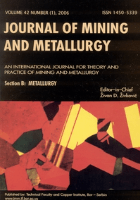
Journal of Mining and Metallurgy Section B-Metallurgy
Connecting researchers with cutting-edge metallurgical developments.Journal of Mining and Metallurgy Section B-Metallurgy is a prominent open-access journal published by the Technical Faculty, Bor-Serbia. Established in 2002, the journal has become a vital platform for disseminating high-quality research in the fields of metallurgy, geotechnical engineering, and materials sciences. With an E-ISSN of 2217-7175, the journal has successfully converged its publication years from 2007 to 2024, indicating its commitment to ongoing academic discourse. The journal is currently ranked Q3 in multiple categories including Geotechnical Engineering and Engineering Geology, Materials Chemistry, Mechanics of Materials, and Metals and Alloys, reflecting its importance in academic research and professional practice. With a Scopus rank that positions it within the 30th percentile across various related disciplines, the Journal of Mining and Metallurgy Section B-Metallurgy serves as an invaluable resource for researchers, professionals, and students who seek to explore cutting-edge advancements in metallurgy and materials science. It provides vital insights that contribute to the development and innovation in these essential fields.
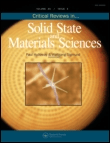
CRITICAL REVIEWS IN SOLID STATE AND MATERIALS SCIENCES
Advancing the Frontiers of Materials ScienceCRITICAL REVIEWS IN SOLID STATE AND MATERIALS SCIENCES, published by Taylor & Francis Inc, is a prestigious journal dedicated to advancing the field of materials science through comprehensive reviews and critical analysis of existing literature. With an ISSN of 1040-8436 and an E-ISSN of 1547-6561, this journal serves as a vital resource for researchers, professionals, and students seeking in-depth understanding of solid-state phenomena and materials applications. Renowned for its high visibility in the academic community, it holds a Q1 ranking across multiple categories including Chemical Engineering, Condensed Matter Physics, and Physical and Theoretical Chemistry, showcasing its impact and relevance in the field. The journal spans its publication years from 1977 to 2024 and is highly regarded, holding prominent positions in Scopus rankings, making it a leading platform for disseminating critical insights and advancing knowledge in materials science. Although it is not an open-access journal, its rigorous peer-review process ensures the highest quality of articles, solidifying its status as a cornerstone for anyone engaged in materials research.

Obrabotka Metallov-Metal Working and Material Science
Driving Progress in Mechanical Engineering and BeyondObrabotka Metallov-Metal Working and Material Science is a pivotal journal published by Novosibirsk State Technical University, focusing on the dynamic fields of mechanical engineering, mechanics of materials, and the science of metals and alloys. With ISSN 1994-6309 and E-ISSN 2541-819X, the journal serves as a crucial platform for disseminating research from Russia and around the globe. Currently classified in the Q4 category for Mechanical Engineering and Mechanics of Materials, as well as Q3 for Metals and Alloys, it encompasses a wide range of studies from fundamental research to innovative applications. Despite its relatively recent inception in 2019, the journal has established itself with Scopus rankings that highlight its growing influence—Rank #122 out of 176 in Materials Science and Rank #510 out of 672 in Engineering. This journal aims to foster collaboration among researchers, professionals, and students by featuring original articles, reviews, and technical notes that address contemporary challenges in metal processing and material science. As it continues to evolve through 2024, Obrabotka Metallov remains dedicated to enhancing the understanding and application of materials science, making it a significant resource for those invested in the future of engineering and technology.

Defence Technology
Transforming Ideas into Defence TechnologiesDefence Technology, an esteemed journal published by KEAI PUBLISHING LTD, stands at the forefront of innovation and research in the fields of ceramics, composites, computational mechanics, mechanical engineering, and metals and alloys. Since its inception in 2013, this Open Access journal has committed itself to disseminating high-quality research, boasting a remarkable Q1 ranking across multiple categories in 2023. With a profound impact in the engineering and materials science communities, it ranks impressively within its Scopus categories—6th in Computational Mechanics and 21st in Metals and Alloys, to name a few—placing it in the top percentiles of performance. The journal's accessibility fosters a global dialogue among researchers, professionals, and students striving to push the boundaries of defence technology and material sciences. By contributing to this journal, authors join a distinguished community aimed at addressing contemporary challenges and pioneering advancements in defence applications.

METALURGIJA
Exploring the depths of metallurgy with global collaboration.METALURGIJA is a distinguished open-access journal published by the Croatian Metallurgical Society, dedicated to advancing the field of metallurgical sciences and engineering. With an ISSN of 0543-5846 and E-ISSN of 1334-2576, this journal has been serving the academic community since its inception, offering valuable insights into condensed matter physics, materials chemistry, mechanics of materials, and metals and alloys. As of 2023, it ranks in Q3 in the fields of condensed matter physics, materials chemistry, and mechanics of materials, and Q2 in metals and alloys, reflecting its engagement with contemporary research and emerging trends. The journal's open-access policy, in place since 2002, ensures that high-quality research is accessible to a global audience, fostering collaboration and knowledge sharing. Located in Zagreb, Croatia, METALURGIJA aims to bring together researchers, industry professionals, and students alike to contribute to systemic advancements in metallurgical research and applications, ultimately enhancing innovation within the materials science community.